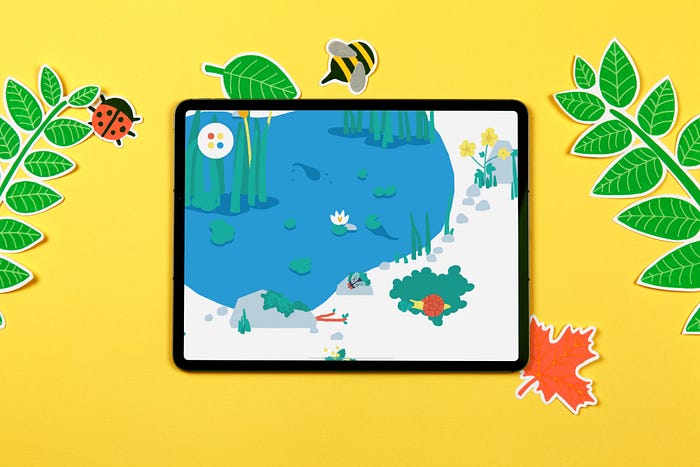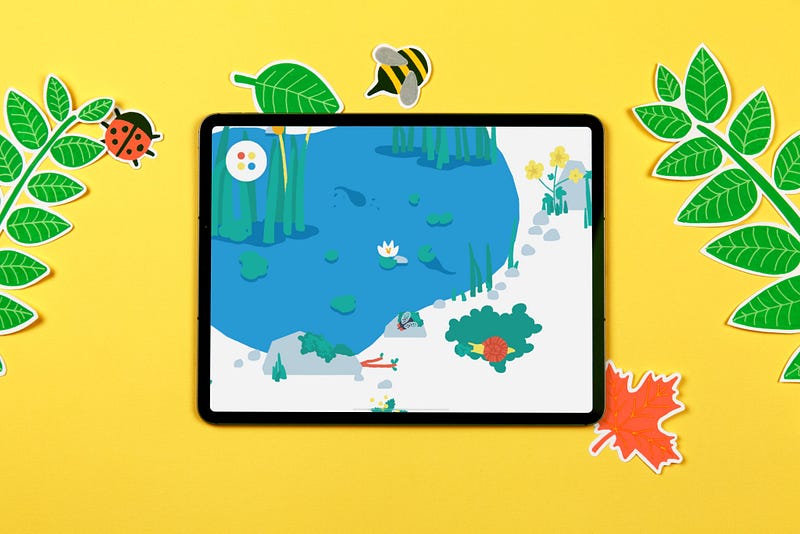How Forest Supports Creative Development Through Exploratory Play
By: Alexandra Heard

Forest is fundamentally a toy of exploration.
Kids open the toy to find a bustling (but not overly busy) forest that’s full of life — there are creatures, critters, trees, flowers and funghi. In this toy, kids will explore a forest floor while experimenting with the flora and fauna around them, learning about the circle of life.
Forest brings many of the fundamental learning experiences of real-world outdoor play into a digital play space. Both independent play and co-play can support different types of learning here, but both boil down to exploration. Let’s dive into both:
Independent Play
During solo play, kids will find that Forest is a playground for experimentation and investigation. It’s desigend to encourage and reward children who touch things, move things and combine things to see what happens — those who experiment are rewarded with greater discoveries!
First attempts to move things in Forest may not work, so children need to try touching funghi, flowers or branches multiple times or in different ways before getting somewhere. During this type of exploration, kids are curious and brave. These skills are foundational STEM skills (something I also touched on in my Silly Blocks blog), and will be translated into your child’s real-world play.

Forest gives kids the space to experiment with different bugs and ecosystems.
When kids play on their own, Forest is especially meditative and calming. Though surely not as relaxing as really being outside, the sounds, the visuals and the openness of the Forest help children find peace while playing and exploring.
If kids aren’t in the mood to try something new, they can simply sit back and watch the critters and creatures go about their day. Things happen in this toy when you interact with it, but also when you just sit back and observe (thanks to the magic of artificial intelligence in our bugs). Other toys in Pok Pok like Town or House are fully player-driven (meaning things won’t happen unless the player interacts with them), but just like a real forest, our Forest has a mind of its own! This brings a new level of excitement and challenge to the table, as kids learn to navigate a world in motion and learn that not everything falls under their control. This also teaches resilience, quick decision-making and coping with challenges.
Playing independently is also wonderful for children’s creativity. They may end up using rocks to make a picture on the Forest floor or make collections of twigs, or ladybirds or pebbles. The sky’s the limit when it comes to their imagination, and everything goes!
Co-play
If you have time to play alongside your little one and engage in co-play, you’ll find that Forest can be a great tool for building a variety of fundamental skills.
Encourage kids to ask “what is that?” and “why does that happen?” to help hone in their research and investigation skills. Sometimes, you might know the answer and can tell them, but other times you may find the perfect opportunity to say “let’s look it up!” (and can go do that together, in the moment).
Grown-ups or older kids can also support a younger child’s investigative skills by playing together with them. Offer prompts and questions like “did you notice that the spider keeps going back to their web?” and then moving up to questions like “what do you think will happen if we move the spider all the way across the forest and into the pond?”. Check out the grown-ups area of the app for more Play Prompts and ideas.

If you have time to play alongside your little one, there are lots of ways to support their learning.
When playing together with an adult, there are also opportunities for embedding numeracy. There are many ‘sets’ of items in Forest that can be grouped together in different ways. Children are often drawn to sorting or making collections of things, and this type of play lends itself beautifully to talking about numbers. If a child has collected four berries, you can say things like “you have four berries there, how many will you have if we add one more?”. Understanding the concept of adding or subtracting numbers under ten is an important step of learning maths as a young child.
Vocabulary and content knowledge can also be built meaningfully by narrating your child’s play and labelling the different features of the Forest. Encouraging them to describe the way the sounds and animations make them feel not only builds vocabulary, but also emotional awareness.
Beyond these conversations during play, Forest can also be a great kicking off point for a number of different conversations with your family about nature. Talking about life (explaining that the bugs are alive, the birds are alive, the plants are alive), the importance of caring for the environment (an opportunity to discuss the effects of climate change) and even the harsh realities of nature (like when the bird eats a ladybird who ventured out from their rock) are all great topics to think about.
When leading these conversations it’s important not to underestimate children’s capability to understand things, and as always, do your best to follow their interests. That’s where the learning happens!

Exploring the outdoors is a great way to extend play from Forest into nature.
Depending on how children engage with Forest, the learning adapts to them. The beauty of this is that children can follow the type of play (and by extension, learning) that they are motivated by on any given day. Not only does this increase the effectiveness of the experience when they’re playing independently, but it can almost always be deepened by co-play with a grown-up or older child. Commenting on what they’re doing explicitly can help develop children’s self-awareness and emotional intelligence (“I see you are watching the wind rustle the leaves today, do you feel like you need a relaxing play today?”).
We hope families enjoy exploring the wonderful world of nature in Pok Pok and beyond. Forest is available now in the latest update of Pok Pok Playroom!
Alexandra Heard is a kindergarten teacher in Melbourne, Australia. She completed her Master of Teaching (Early Childhood) at the University of Melbourne in 2016. Since then, Alexandra has worked as a kindergarten teacher to four and five year-olds. In addition to teaching, Alexandra also works with qualified teachers and educators to provide them with professional development opportunities to improve their own work with preschool-aged children.











